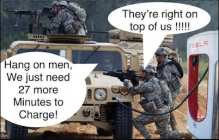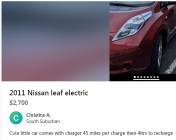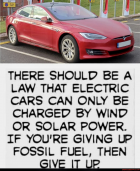You are using an out of date browser. It may not display this or other websites correctly.
You should upgrade or use an alternative browser.
You should upgrade or use an alternative browser.
Electric Cars -- anyone own one?
- Thread starter muleman69
- Start date
- Status
- Not open for further replies.
Brians356
Silver $$ Contributor
How will an EV do in the vast, sparsely-populated western US, compared to a conventional gasoline ICE vehicle? Consider only time to travel (ignoring cost to recharge vs refuel). After all, time is money, right?
Suppose I want to drive from my home in Reno, Nevada to my mother's home in Lewiston, Idaho. Using possibly the most popular "EV route planner" web site (ABetterRoutePlanner.com) for the Tesla Model 3 Long Range's trip, and Google Maps for a generic vehicle (my Tacoma), both pick the fastest route (assuming speed limits are observed.)
The EV route includes time to recharge, while Google does not, so assuming two gasoline stops of ten minutes each (with a quick visit to the lavatory) we can add, say, 22 minutes (not a random figure, as we'll see) to the ICE trip. Here's how the 705-mile EV route (on the left) compares to the 664-mile route my Tacoma (on the right) could do (adding the 22 minutes):
Tesla: 13h 9m
Taco: 11h 9m (10h 47m + 22m)
That's exactly 2 hours longer in the Tesla (and why I chose 22 minutes for refueling.)
But wait: Notice the Tesla trip assumes letting the battery drain down to only a 10% charge (in Hines, OR) and 13% (in Pendleton, OR). Yikes! To avoid that precarious situation in sparsely populated E. Oregon, you'd need to spend additional time charging in Alturas and/or Hines, where each recharge was aborted at only 73% and 74% respectively. When on a road trip in an ICE, you top off, you don't just add enough fuel to get you to the next gas station! You want a safety reserve at all times.
Also, the battery recharge schedule assumes optimal ambient conditions, and not having to use the cabin heat or A/C. These significantly affect EV range, but only minimally affect ICE vehicle range and refuel time.
Finally, arriving in Lewiston the battery is down to only 15% (not shown below) so even more time should be spent charging in Pendleton (not stopping at 57% charge) to have a larger reserve upon arrival. These EV scenarios always omit the time required at the destination to build up enough charge to actually drive around there! For an apples-to-apples comparison, we really should add a destination recharge to the end-to-end ET, since a gas vehicle is likely to have enough gas in the tank to drive around a couple of days. In my case I'm refilling in Payette, Idaho, and will have about half a tank when I arrive in Lewiston. In fact, I won't need to add fuel for the entire week I'm there.
Notice if I'd driven the same route the Tesla had to take (for access to charge stations!) it'd taken me only 12h 16m (plus 22m refuel time) equals 12h 28m vs Tesla's 13h 9m.
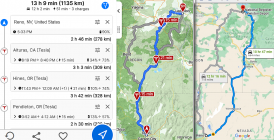
-
Suppose I want to drive from my home in Reno, Nevada to my mother's home in Lewiston, Idaho. Using possibly the most popular "EV route planner" web site (ABetterRoutePlanner.com) for the Tesla Model 3 Long Range's trip, and Google Maps for a generic vehicle (my Tacoma), both pick the fastest route (assuming speed limits are observed.)
The EV route includes time to recharge, while Google does not, so assuming two gasoline stops of ten minutes each (with a quick visit to the lavatory) we can add, say, 22 minutes (not a random figure, as we'll see) to the ICE trip. Here's how the 705-mile EV route (on the left) compares to the 664-mile route my Tacoma (on the right) could do (adding the 22 minutes):
Tesla: 13h 9m
Taco: 11h 9m (10h 47m + 22m)
That's exactly 2 hours longer in the Tesla (and why I chose 22 minutes for refueling.)
But wait: Notice the Tesla trip assumes letting the battery drain down to only a 10% charge (in Hines, OR) and 13% (in Pendleton, OR). Yikes! To avoid that precarious situation in sparsely populated E. Oregon, you'd need to spend additional time charging in Alturas and/or Hines, where each recharge was aborted at only 73% and 74% respectively. When on a road trip in an ICE, you top off, you don't just add enough fuel to get you to the next gas station! You want a safety reserve at all times.
Also, the battery recharge schedule assumes optimal ambient conditions, and not having to use the cabin heat or A/C. These significantly affect EV range, but only minimally affect ICE vehicle range and refuel time.
Finally, arriving in Lewiston the battery is down to only 15% (not shown below) so even more time should be spent charging in Pendleton (not stopping at 57% charge) to have a larger reserve upon arrival. These EV scenarios always omit the time required at the destination to build up enough charge to actually drive around there! For an apples-to-apples comparison, we really should add a destination recharge to the end-to-end ET, since a gas vehicle is likely to have enough gas in the tank to drive around a couple of days. In my case I'm refilling in Payette, Idaho, and will have about half a tank when I arrive in Lewiston. In fact, I won't need to add fuel for the entire week I'm there.
Notice if I'd driven the same route the Tesla had to take (for access to charge stations!) it'd taken me only 12h 16m (plus 22m refuel time) equals 12h 28m vs Tesla's 13h 9m.

-
Last edited:
I'm ready to go back to horses.yall can keep all this crap.
Brians356
Silver $$ Contributor
Interestingly, Tesla's own route planner adds another hour to ABRP's calcs, using the same route and chargers, owing to Tesla's more conservative (longer) charge stops. That's 3 extra hours for the trip vs the ICE route.Notice if I'd driven the same route the Tesla had to take (for access to charge stations!) it'd taken me only 12h 16m (plus 22m refuel time) equals 12h 28m vs Tesla's 13h 9m.
-
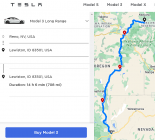
-
F’EVs!
I wanna hear some noise, an smell some smoke!
I wanna hear some noise, an smell some smoke!
ISS
Gold $$ Contributor
Me, I will have one of the nephews bring a saddle horse to the house and make my short trips that way. Worked for thousands of years.
Ever notice how the car companies and the feds never mention how much the E-fill will cost? Here in town the dealers say fuel costs vary too much to do that. Hmmmm, like diesel prices don't? My brother in the St Louis area pays about seventy cents less than I do here in Idaho.
If you consider how overly socialist this crap is, the answer is obvious. Flip one switch and every E-station shuts off. For me, I am sticking with my Dodge Eco Diesel.
Ever notice how the car companies and the feds never mention how much the E-fill will cost? Here in town the dealers say fuel costs vary too much to do that. Hmmmm, like diesel prices don't? My brother in the St Louis area pays about seventy cents less than I do here in Idaho.
If you consider how overly socialist this crap is, the answer is obvious. Flip one switch and every E-station shuts off. For me, I am sticking with my Dodge Eco Diesel.
jackieschmidt
Gold $$ Contributor
My Bolt EUV just topped 10,000 miles. I have a 92 mile commute 6 days a week.
That is what it is good for.
That is what it is good for.
gme
Site $$ Sponsor
the EV industry (and the feds) don't want you to think about it.,...
https://www.saferemr.com/2014/07/sh...5YaMXygUJcYyJgKSNdli5Gc7fOM8n0wJVU-zt_JAtyO4M
https://www.saferemr.com/2014/07/sh...5YaMXygUJcYyJgKSNdli5Gc7fOM8n0wJVU-zt_JAtyO4M
NorCalMikie
Gold $$ Contributor
And you'll be reading it with your cell phone/ I Pad in your lap and wondering WHY your babies are born NAKED???
NorCalMikie
Gold $$ Contributor
joshb
Gold $$ Contributor
I saw an electric motorcycle today. I thought “that looks kinda cool” so when I got home, I looked it up. $6500 Real world range-37 miles. That makes it DRT for me! The Company is already in trouble. Their spin-up for a public offering flopped OOPS!!
There is some interest from the man bun crowd, tho!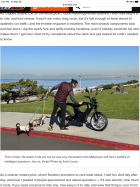
There is some interest from the man bun crowd, tho!

I don’t have an electric car but. I used to have a Lionel Train. Does that count?
jackieschmidt
Gold $$ Contributor
Does anybody besides me drive an Electric?
I commute 92 miles a day, 6 days a week, and I rarely ever see one besides mine.
I commute 92 miles a day, 6 days a week, and I rarely ever see one besides mine.
Last edited:
Brians356
Silver $$ Contributor
Hey, if you're gonna save the planet** you've gotta break a few Third-world kids.Gretas Cobalt farm...
(** Save it for the trans baby whales, nematodes, and other living things except humans.)
-
Brians356
Silver $$ Contributor
I know a couple of BEV owners personally. There are many Teslas around here because Tesla has a yuuuge battery factory just outside of the city. The building is 3000 feet long, and the paved parking lot holds 2800 cars, plus about that many in the graded overflow parking.Do s anybody besides me drive an Electric?
I commute 92 miles a day, 6 days a week, and I rarely ever see one besides mine.
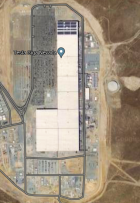
-
NorCalMikie
Gold $$ Contributor
LOTS of Teslas in the San Francisco Bay Area. LOTS!! I wonder what happens as the Summer heats up, the rolling blackouts start in and they CAN"T charge their EV's?? 
There's more up North than there use to be. I see NEW Tesla charging station going in at the larger Grocery store parking lots. 15 to 20 spots but only one maybe two cars parked/charging. Must be a write off thang??
Must be a write off thang??
And WHO in their right mind would leave their EV charging with No One Around?? BETTER be set up for home charging.
There's more up North than there use to be. I see NEW Tesla charging station going in at the larger Grocery store parking lots. 15 to 20 spots but only one maybe two cars parked/charging.
And WHO in their right mind would leave their EV charging with No One Around?? BETTER be set up for home charging.
- Status
- Not open for further replies.
Similar threads
Upgrades & Donations
This Forum's expenses are primarily paid by member contributions. You can upgrade your Forum membership in seconds. Gold and Silver members get unlimited FREE classifieds for one year. Gold members can upload custom avatars.

Click Upgrade Membership Button ABOVE to get Gold or Silver Status.
You can also donate any amount, large or small, with the button below. Include your Forum Name in the PayPal Notes field.
To DONATE by CHECK, or make a recurring donation, CLICK HERE to learn how.

Click Upgrade Membership Button ABOVE to get Gold or Silver Status.
You can also donate any amount, large or small, with the button below. Include your Forum Name in the PayPal Notes field.
To DONATE by CHECK, or make a recurring donation, CLICK HERE to learn how.











